UFO Case Report:
The 'Alien Autopsy' Film (Socorro, NM 1947 UFO Crash)
Date: , 1947
Location: Socorro, New Mexico, United States
In 1995 London based businessman Ray Santilli caused what has been arguably the biggest controversy in the entire history of UFO research when he launched his 'Alien Autopsy' film across the front pages of magazines and via the TV screen in over 20 different countries.
|
Video
Clip A sample video clip from the "alien autopsy" film. |
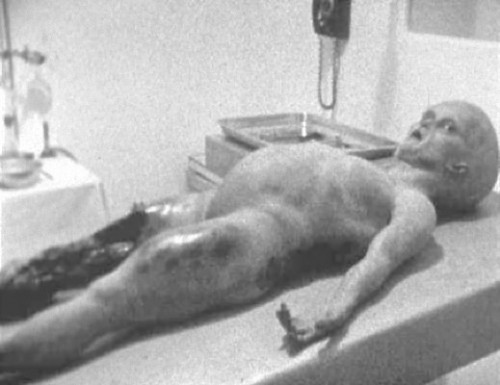
A scene from the "Alien Autopsy" film.
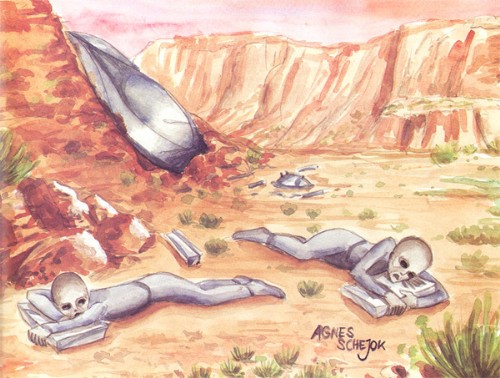
Crash scene, drawn by Agnes Schejok based on the cameraman's sketches. (credit: Hesemann & Mantle)
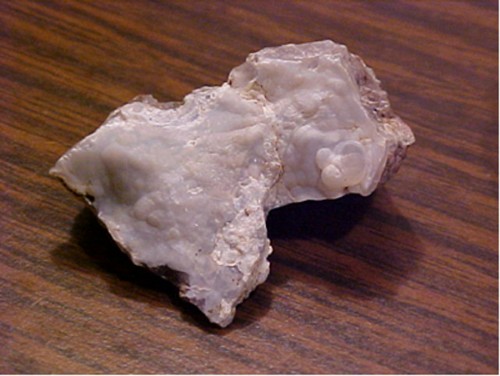
Sample of the material that was found at the likely crash site discovered by Ed Gehrman. Upon analysis, the material was found to be Cristobalite, a high temperature indicator, forming at above 1450 degrees Celsius. Cristobalite is not found normally under the conditions that exist at the crash site.
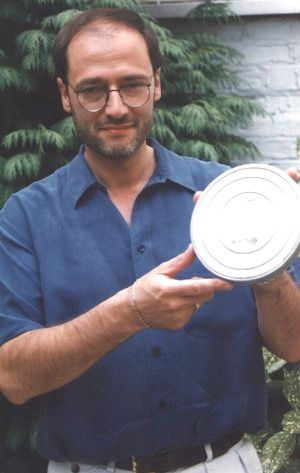
Ray Santilli pictured in 1995 holding a canister of the alleged alien autopsy film.
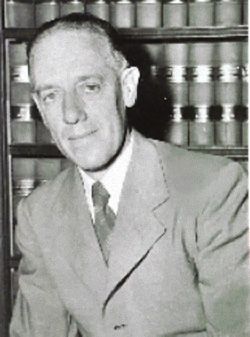
According to the cameraman the autopsy was performed by "Dr Bronk" and "Dr Williams". Pictured above, Prof. Dr Detlev Bronk (1897-1975) was no surprise, since his name already appeared in the controversial "Majestic 12" documents. He was Chairman of the National Research Council, America's leading biophysicist and a member of the Advisory Committee of the Army, Air Force and of the Atomic Energy Commission. (info: Hesemann)
Classification & Features
Type of Case/Report: MajorCase
Hynek Classification:
Special Features/Characteristics: Alien Photograph, Crash/Retrieval, Humanoid/Occupant, Physical Trace
More Articles on this Case
The Alien Autopsy Cameramans Interview
Alien Autopsy Archive
On December 19, 1996, Japanese based, Fuji TV, braodcasted a 6 minute video tape which presented an old guy anserwing some questions that "Alien Autopsy: Fact or Fiction" producer, Robert Kiviat supplied to Ray Santilli to give to the cameraman. ...We've been the first to secure the UNCUT 12 minute version (Thx Tom G.) Little new was uncovered, but we do know what he looks like, if indeed he is "the guy." The following is the complete transcript to the interview. R
Article on the "Santilli Alien Autopsy"
Ed Gehrman
I was one of those folks skeptical of the Roswell Alien Autopsy footage. [Then in 1995, on Art Bell's radio show, I listened to] an expert on movie cameras explain film dating. The substance of his remarks and the subsequent wrapup by Bell seemed to indicate that the Roswell Alien Autopsy footage, shown on Fox TV the previous week, was probably authentic. I decided to reexamine my assumptions about this potentially explosive but controversial film footage. R
Book: 'Alien Autopsy Inquest' by Philip Mantle
Philip Mantle's new e-book entitled 'ALIEN AUTOPSY INQUEST' is now available for purchase and download. "It is quite literally THE most comprehensive work to-date on what is THE most controversial film in the entire history of UFO research." (Mantle) R
Report on the Alleged Crash Site (PDF format)
Wendy A. Connors (2004)
"Toward Consideration of an Alleged Crash and Recovery of an Unknown Aerial Craft Near the Villages of Socorro and San Antonio, New Mexico on May 31, 1948". Summary report by Wendy Connors on the investigation of the alleged "alien autopsy" crash site discovered by Ed Gehrman.
The Alien Autopsy Film: Facts vs Armchair Research
Michael Hesemann, Nexus Magazine, Volume 3, #6 (Oct-Nov '96)
While nobody has been able to present any proof that the Santilli autopsy footage was faked, we have some convincing indications that the film might very well be genuine. If it is a hoax, it is definitely the most ingenious fake of the century. The following is a summary of results from the the International Research Team's first year of investigation. R
The 'Roswell' Film Footage
George Wingfield, Flying Saucer Review (1995) (credit: Alien Astronomer website)
Article on the alien autopsy film, written in 1995 shortly after the first public showing of the film by Ray Santilli. (Note: Using the name "Roswell Film Footage" may be a misnomer, since the creature in the film may be from a different crash.) R
Alien Autopsy Update
Philip Mantle, former Director of Investigations for BUFORA
Recap and update on the investigation of the alien autopsy film, by Philip Mantle, one of the main researchers who is involved in investigating the case. "While most UFO researchers and members of the public alike have assigned the 'Alien Autopsy' film to the hoax bin, this short article shows that it is not as clear cut as some would have you believe. R
Creatures With No Business Here: The Cameraman's Crash Site
Ed Gehrman
In 1995 when the alien autopsy was more immediate and pregnant with possibility, several researchers decided to try to find the crash site described by the cameraman. Unfortunately, they were two miles short of their goal. Had they traveled a little further down the arroyo they were searching, they would have come to the site my brother and I found and the whole AA story might have had a different reception.
Print / Other References
Michael Hesemann & Philip Mantle. 'Beyond Roswell.' Marlowe & Co., New York, 1997.
Full Report / Article
Source: Michael Hesemann, Nexus Magazine, 1996
From 'Alien Autopsy Update', by Philip Mantle
September 22, 2001
In 1995 London based businessman Ray Santilli caused what has been arguably the biggest controversy in the entire history of UFO research when he launched his 'Alien Autopsy' film across the front pages of magazines and via the TV screen in over 20 different countries. By far the most popular TV documentary made at the time was the Fox Network's 'Alien Autopsy - Fact or Fiction?' which has often been repeated on numerous cable and satellite stations.
RECAP
For those who are unaware of this controversial film, a brief recap might be in order. London video producer Ray Santilli claimed that in l992 he was in Cleveland, Ohio in the USA looking for vintage film clips of rock-n-roll performers from the l950's. People like Elvis Presley and Pat Boone were at the top of his list. Santilli claimed that he met an elderly gentleman from who he purchased a rare clip of the late Elvis live on stage. The elderly chap had filmed the piece himself while working as a freelance cameraman in l950's. Shortly before returning home Santilli was contacted by this elderly cameraman again who this time had something different to offer. The story he told was that prior to being a freelance cameraman he was a cameraman with the US Army and in l947 he had been flown to Roswell, New Mexico on a special assignment. Initially he was informed that he was to film the crash of a Soviet spy plane but on arrival it became clear that this was no Russian plane. Instead he claimed to have filmed the UFO crash at Roswell in l947 and not only that, but the actual autopsy of 2 of the dead aliens.
Quite naturally Santilli was more than interested and at a later date he visited the cameraman at his home to view this other footage. To his amazement it did indeed appear to show the autopsy of an alien. Santilli immediately agreed to buy the film for cash, the only other condition being that he was never to reveal the identify of the cameraman himself. Santilli, not having the amount of money involved, reported to be around $150,000, but never confirmed, eventually turned to his German business partner Volker Spielberg for assistance. Over the next couple of years Santilli purchased the film and transported it to the UK where it was transferred to video. In l993 Santilli contacted myself to see if I might be able to assist in the making of a UFO documentary. Eventually he told me of the film he had purchased and his plans to commercialise it. It was not until early l995 that I first saw any of the film. My wife Sue and I visited Santilli's offices in London on several occasions to view the film. At the time I was the conference organiser for the British UFO Research Association (BUFORA) and already had a conference planned for August l995. I asked Santilli if he would show the film at the conference and he agreed to do so.
In the meantime, after a private screening organised by Santilli in London to an invited audience only, he set about selling the rights to the film to a wide variety of publishers and TV companies around the world. First to publish stills from the film was VSD in France and soon copies were flying around the world via the internet. The day after our conference in August l995 saw the film broadcast on TV around the world. And the rest, they say, is history.
-------------------------------------
From: The Alien Autopsy Film: Facts vs Armchair Research
Michael Hesemann, Nexus Magazine, Volume 3, #6 (Oct-Nov '96)
THE 'ROSWELL FOOTAGE' RELEASE
About a year and a half ago, on 5th May 1995, the London-based film producer Ray Santilli for the first time presented his alleged alien autopsy footage to an audience of invited media representatives and UFO researchers at the London Museum. Even before that date, a very emotional debate had already started. Angry ufologists had challenged Santilli to shut up or work together with them, while others had claimed from the very beginning that the film is a hoax just because it doesn't fit into their concept of what happened in New Mexico in the summer of 1947.
Santilli's marketing policy, his commercial exploitation of the film, his ignorance in the UFO field and his violation of all the unwritten protocols of the UFO community didn't find many friends among ufologists, and quite soon many screamed "Hoax!" without being able to prove anything. One researcher even concluded, "There is no [16 mm] film and no cameraman", after quoting page after page of all the rumours, second- and third-hand information and inconsistencies among Santilli's claims (or alleged claims), to prove that he was right from the very beginning when he suspected a scam, because the being on the autopsy table looked "too humanoid to be an extraterrestrial", yet ignoring that this is exactly how most eyewitnesses describe crashed ufonauts.1
Unfortunately, those who searched for the truth, wherever it might be, were few in number. Willing to listen to Santilli first, before they judged and checked out the information they could get before asking for more, were mainly Philip Mantle (UK), Bob Shell (USA) and Michael Hesemann (Germany)-the International Research Team (IRT)-joined by Maurizio Baiata and Roberto Pinotti (Italy), Johannes Baron of Buttlar (Germany), Odd-Gunnar Roed (Norway), Hanspeter Wachter (Switzerland), Col. Colman VonKeviczky, Dr Bruce Maccabee, Joe Stefula, Lt. Col. W. C. Stevens, Ted Loman, Robert Morning Sky, Llewellyan Wykel and Dennis Murphy (USA), and others.
Let me point out that we found Ray Santilli always very friendly, helpful and cooperative although sometimes limited in his actions by agreements with his business partners and the cameraman. I wonder if any 'major international media corporation' would ever have been even nearly as open to any reasonable research approach as Mr Santilli indeed was. The following is a summary of results from the IRT's first year of investigation.
THE CAMERAMAN
Yes, there is a cameraman. We located people, besides Santilli, who had spoken to him over the phone: Gary Shoefield of Polygram, Philip Mantle, John Purdie of Channel Four (UK) and the secretary of David Roehring of Fox Network, USA. He is American, an old man, and lives in Florida. He was in hospital when Gary Shoefield wanted to meet him, and was coughing when Philip Mantle had him on the phone. According to his story he had polio as a child.2 Polio victims at that time mostly walked with a limp. He could not have had a bad hand, otherwise he could not have worked as a cameraman, but maybe he had a bad leg. The movement of the cameraman in the film indicates this, since he doesn't move smoothly. Bob Shell enquired among senior US military cameramen if they could remember a colleague from the 1940s with a bad leg. They knew one. His name is Jack "X", and he is exactly the age claimed for the Santilli cameraman: eighty-six.3
The cameraman is not Jack Barnett-a name used originally by Santilli to protect the identity of the true cameraman. Jack Barnett worked for Universal News, filmed Elvis Presley at a high-school concert in 1955 and died in 1969. Jack X did not work for Universal, but filmed Elvis at another concert, an open-air one, when the Universal cameramen were on strike.4 The cameraman agreed to be interviewed by a major US TV network.5
In April 1996 Bob Shell was contacted by the US Air Force following an enquiry from President Clinton's scientific adviser, Dr John Gibbons. The USAF Captain told Shell that they had located footage from the same stock in their archives and verified that at least part of the Santilli material is genuine, and shows no dummy and no human. They knew the cameraman's name-Jack X-but asked Shell to forward an address, since the military records building in St Louis had had a fire and many records had been lost. A search would be time-consuming and expensive.6
When we asked for details about the crash site, we became convinced that the cameraman indeed has an excellent knowledge of the area in question. With Ray Santilli as the intermediary-and Santilli did not know anything about the area in question and insisted on calling Socorro "Sorocco"-he even described a ruined bridge that we could locate only on our third visit to the area. He knew exactly what he was talking about.
Although some have criticised the cameraman's technique in the autopsy film, other military cameraman think this is exactly the way they, too, would have filmed it.
"The cameraman keeps moving to get out of the way of the surgeon and keeps trying to get the best perspective. The job of an army cameraman is to record a procedure on film, not to deliver beautiful pictures. And that, here, is an adequate filmic protocol," said Dr Roderick Ryan, US Navy cameraman during the '40s and '50s who filmed many secret government projects including the atomic tests on Bikini Atoll.7
"Among these circumstances, no one could have made a better job...he was not only a well-educated and experienced movie man, but, additionally, in full knowledge of editing and production of documentaries. Evidence: filming the autopsy activities from various view angles," said Col. Colman VonKeviczky, who studied at the UFA Film Academy in Berlin Babelsberg, was head of the audiovisual division of the Royal Hungarian General Staff, cameraman and director of the 3rd US Army at Heidelberg and member of the audiovisual department of the United Nations in New York.8
THE FILM STOCK
Careful study of stills made from the original film and high-quality Betacam copies confirmed that the film was indeed shot on 16-mm material. The camera handling seen on the autopsy film indicates the use of a small, lightweight camera with fixed lenses (therefore, the out-of-focus close-ups), like the 16-mm Bell & Howell Filmo Camera used by US military cameramen in the '40s-the camera the cameraman claims he used.9
Leaders of 16 mm film were sent to Kodak Hollywood, London and Copenhagen and turned out to bear the symbols (a square and a triangle) used by Kodak either in 1947 or in 1967.10
Two segments with three frames each, one clearly showing the autopsy room, were given to Bob Shell, editor of Shutterbug magazine and also a phototechnical consultant for the FBI and the US courts. After a careful physical analysis, Shell confirmed the segments to be pre-1956 16-mm film. In 1956 Kodak changed its film-base from acetate-propionate to triacetate, and the samples were clearly on acetate-propionate film. The film type was Super XX-Panchromatic Safety Film, a high-speed film used for indoor filming but which had a life-span of no more than two years, when cosmic radiation would cause a 'fogging' of the material. Shell is sure the film was exposed and developed within two years. This, at least, dates the film as pre-1958.11
THE EQUIPMENT & OBJECTS IN THE AUTOPSY ROOM
Everything in the film dates to the time in question. The telephone is an AT& model from 1946,12 and spiral cables had been optional since 1938 and standard for US Army telephones.13 The wall clock is a model on the market since 1938,14 and the microphone is a 1946 Sheer Bros mike.15 The table with the instruments was standard equipment for a pathologist, as confirmed by Prof. Cyril Wecht, ex-President of the American Academy of Forensic Sciences.16 The bone hammer was not unusual; nor was the Bunsen burner which, in autopsies, served the purpose of burning away body fat.
THE BODY
The corpse on the autopsy table has been the subject of many disputes as to whether it is a dummy, a girl with a genetic disorder or, indeed, an alien. Nearly all special effects (FX) experts concluded that it is certainly possible to fake footage of a realistic-looking autopsy. There have been many concerns about 'snuff' movies and the origin of the corpses used in them. South America had been named as a possible origin, but reports from there have indicated the use of very realistic dummies. However, no one has found any evidence of special effects being used in this autopsy film-although today, unquestionably, nearly everything can be faked with the latest state-of-the-art FX techniques.17
On the other hand, pathologists and physicians from all over the world who saw the film were pretty sure the body was not a dummy, but actually a corpse-human or humanoid.
It is indisputable that some of the characteristics of different genetic disorders can be found in the being on the autopsy table-mostly disorders such as Turner's syndrome or progeria, combined with polydactylism (which is not a typical element of Turner's syndrome, although possible in combination with it) and other anomalies. This prompted a German dermatologist, Dr T. Jansen of the Policlinic of the University of Munich, to publish a study in a medical journal, trying to prove that the body is that of a girl who died from a rare form of progeria.18 On the other hand, he forgot to explain why there could be two girls with identical symptoms including polydactylism, when progeria is so rare that there are only 20 cases worldwide. Unfortunately, the only case of Turner's syndrome twins, although obviously documented on film, was never published in the medical literature.
Indeed, Dr Jansen's 'findings' do not explain the extreme precautions taken when the autopsy was performed, i.e., why would the team have worn bio-hazard protection suits if the body had a genetic disorder, and why would the being have been fitted with black eye-lenses? Although Dr Jansen diagnosed a stroke (common for progeria patients) as the cause of death, this does not explain the damaged right leg, the broken and swollen left leg, the cut-off right hand and a bruise at the left temple with a possible bullet wound. Should we assume that our creature broke its legs, cut its right hand and shot a bullet in its head before it died from a stroke?
More than that, Jansen's explanation for the missing navel couldn't convince us, either. To quote Dr Jansen, "It's like if you put up an umbrella: the unevenness disappears."19
On the other hand, quite a number of pathologists concluded that the being was not human at all, since its inner organs were like nothing they had ever seen:
Prof. Christopher Milroy, Home Office Pathologist, University of Sheffield, UK: "Although a close-up of the brain was shown, it was again out of focus. However, the appearance was not that of a human brain."20
Prof. Mihatsch, University of Basle, Switzerland: "As for the organs removed, they could not be tallied with any human organs."21
Prof. Cyril Wecht, Ex-President, American Academy of Forensic Sciences, USA: "I can't place these structures in an abdominal context... I find it difficult to bring in any connection with the human body as I know it. The structure that must be the brain, if it were a human being, does not look like a brain...it does not seem to be a human being."22
Dr Carsten Nygren, Oslo, Norway: "This is not a human brain. It is...much too dark."23
Prof. Pierluigi Baima Bollone, University of Turin, Italy: "When we look at the inner organs of the body we find no single organ that in any way resembles any human organ. The main organ, which could be the liver, has neither the shape nor the location of a human liver. The face of the alleged extraterrestrial shows surprising anatomical features: very big ocular orbits, a very flat nasal pyramid, a mouth somehow wide open...nevertheless, the face is flat, there is no evidence of facial musculature which is present in human beings and is responsible for the large variety of facial expressions of the human species... My overall impression is that we are dealing with a creature that seems to belong to our species but is so clearly different from us that it seems absurd to speculate about the similarity."24
There was not a single physician or pathologist who, after watching the full film, concluded it was a hoax or that the being on the table was a dummy. They all agreed the corpse was of a living, biological entity-human or not.
THE PATHOLOGISTS
According to the cameraman the autopsy was performed by "Dr Bronk" and "Dr Williams".
Prof. Dr Detlev Bronk (1897-1975) was no surprise, since his name already appeared in the controversial "Majestic 12" documents. He was Chairman of the National Research Council, America's leading biophysicist and a member of the Advisory Committee of the Army, Air Force and of the Atomic Energy Commission-certainly a person to whom the supervision of an autopsy of this relevance could have been entrusted. After his death, all his papers and documents were preserved at the Rockefeller Institute for Medical Research, of which he was President from 1953.25
Dr Bronk was a very methodical person, kept detailed diaries and all his correspondence, notes and dates. But when Bob Shell wanted to look through his papers and diaries for 1947, he learnt that, mysteriously enough, this is the only year for which all the records are missing. None of the friendly librarians could tell him what had happened to them or why they are still missing.26
Dr Williams might have been Dr Robert Parvin Williams (1891-1967), who was Special Assistant to the Surgeon General of the Army at Fort Monroe, Virginia. He was a Lt. Col. in 1947 and was promoted to Brig. General in 1949.27 Alone, the naming of Dr Williams-who was the right man in the right place for the task-indicates the cameraman had some inside knowledge.
[...]
According to the cameraman, four living aliens were found at the crash site. One did not survive the recovery operation, the second and third died about four weeks later, and the fourth survived until May 1949.
We do not know anything about the autopsy of the first creature, and it might very well have been that it was subjected to a 'big' scientific autopsy.
The cameraman filmed the second and third autopsies on 1st and 3rd July 1947, when the main concern might have been to find out the cause of their sudden deaths in order to find a way to keep alien no. 4 alive-unless they could establish communication and find out why these visitors had come to Earth. This was surely of a higher interest for the national defence forces than a scientific study of an alien life-form. Nevertheless, we assume that organs were taken for further study during the dissection.
Furthermore, according to the cameraman, the fourth alien was autopsied scientifically in a medical theatre in Washington, DC, in the presence of leading scientists from the US, England and France.34
ROSWELL OR SOCORRO?
Ray Santilli's claim that the film was "the Roswell footage" caused a lot of controversy, since none of the witnesses to the July 1947 UFO crash/retrieval event had confirmed either the bodies or the debris. Indeed, the corpses found in Roswell were smaller, more slender, and had four or five fingers, according to eyewitnesses.51 None ever mentioned six fingers. In any case, if the film were a fake, why did those responsible for it not care to read at least one of the many books on this subject or see the excellent TV mini-series, Roswell, by Paul Davies, as shown on Showtime?
The very first information I got from Santilli about the source of the film made me wonder if it actually had anything to do with Roswell at all. Ray already insisted on 5th May 1995 that the autopsies had been filmed on 1st and 2nd July 1947, and that the recovery had taken place "in the beginning of June"-one month too early for Roswell.
When I went to Roswell on 30th June 1995 to confront the eyewitnesses (including Robert Shirkey, Glenn Dennis and Frank Kaufmann) with the just-released stills from the film, I asked Santilli for details about the crash site. He could only tell me it was "about four-and-a-half hours away", "close to White Sands test site" and "an Apache reservation", and "at the northern shore of a small dry lake at the end of a small canyon". I asked him to call the cameraman to obtain more detailed instructions, which, indeed, he did. He said the crash site was "between Socorro" (Ray said "Sorocco") "and Magdalena".
By the end of July 1995, Santilli released the full story of the cameraman who confirmed he had learnt of the crash on 1st June 1947-which dates the event back to the late hours of 31st May 1947. Date, location and everything we see on the film didn't fit with Roswell. Conclusion: it was a different event.
The fact that the cameraman had been flown into Roswell and brought to the crash site by car, caused him to believe he'd been involved in "the Roswell incident" that he'd heard about-and Santilli believed him.
CONCLUSION
While nobody has been able to present any proof that the Santilli autopsy footage was faked, we have some convincing indications that the film might very well be genuine. If it is a hoax, it is definitely the most ingenious fake of the century.
Instead of continuing the polemic of the last year or so, serious UFO researchers should continue to evaluate the evidence and search for the truth, in what might turn out to be the most provocative proof yet that we are not alone in the Universe.
Case ID: 809
edit: 809
FAIR
USE NOTICE: This page may contain copyrighted material the
use of which has not been specifically authorized by the
copyright owner. This website distributes this material without
profit to those who have expressed a prior interest in receiving
the included information for scientific, research and educational
purposes. We believe this constitutes a fair use of any such
copyrighted material as provided for in 17 U.S.C § 107.





